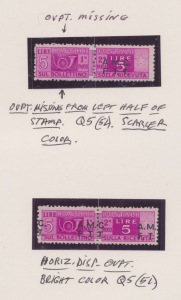One of the constants in history is the malleability of political boundaries. In America, we have become a bit inured to this fact because our own geography has been so steady, adding only Hawaii and Alaska to our country in the last century. But Europe is used to change, and nowhere in Europe has there been more change than in the Balkan area. Trieste is a city that lies at the end of the Adriatic and has had many masters during its history.
Trieste began the stamp period as part of the Austro-Hungarian empire. As such, like any city in the empire, it used Austrian stamps. After WWI, Austria ceded the area that included Trieste to Italy, and the importance of Trieste as a commercial center declined. Trieste had been an important port city for Austro-Hungary—it was its port to the Mediterranean Sea (in fact it was at Trieste that the Austro-Hungarian fleet was based. After defeat in WWI, both Austria and Hungary were landlocked, but it was this former fleet that Admiral Horthy—the WWII leader of Hungary—had been the commander of); Italy had many such ports on the Adriatic that better served Italian industrial and farming interests, so that after unification with Italy, Trieste had a decline in wealth and population. Philatelically, Italian stamps replaced Austrian stamps for use in Trieste from after WWI until after WWII. Italy was on the losing Axis side in WWII, and after the war there was some question as to what the geopolitical disposition of the city would be. The Allied Military Government that controlled Italy after the war overprinted Italian stamps for use in Trieste “AMG.” They are a fascinating specialty with many varieties and rare stamps. By the mid 1950s, Trieste returned to the political control of Italy, and special Trieste stamp issues ceased and were replaced by ordinary Italian postage stamps.
Trieste issues have always been influence by an American dealer named Joe Bush. Bush was involved in Trieste stamps from the earliest, and he may well have been a soldier stationed at Trieste or had close contact with those who were. In any case, Bush seemed to have his hand on every variety and was able to obtain full panes so that he could produce gutter pairs and other specialty items. It’s not clear how influential Bush was in having the many Trieste errors issued, but he certainly seemed to acquire many of them right from the post office and had spaces for them in his earliest albums. This close relationship of Bush with Trieste (like the similar relationship of the Canadian dealer Bileski with the stamps of Liberia) has been problematic. In the early years, many collectors avoided Trieste issues because there were so many errors and specialty items about which there were questions of legitimacy. But as time passed, people became less aware of the provenance of these items, and, as no new quantities of any of the rarities came to the market, it became safer to collect this area. Today, Trieste is an intensely specialized sub-specialty of Italian philately.
 Europe has two other city states with similar histories to Trieste. They are Danzig and Fiume. Each is a good sized city located at the edges of historically conflicting larger States; each has large commercial significance; and each has had three philatelic incarnations in the twentieth century. These are all very interesting countries to collect, and because they are countries that have had different masters, they have the popularity that comes from a broadened collector base (the natives and the collectors of the two countries that have dominated them). Each of the three have many varieties of their stamps, many of which are quite pricey but many more of which are more modest in price, and each can be collected as seriously or as casually as you wish. Whenever collectors ask where they can get the most philatelic bang for their buck (in terms of study, rarity, the chase, and the satisfaction of obtaining difficult items), these three areas are at the top of the list.
Europe has two other city states with similar histories to Trieste. They are Danzig and Fiume. Each is a good sized city located at the edges of historically conflicting larger States; each has large commercial significance; and each has had three philatelic incarnations in the twentieth century. These are all very interesting countries to collect, and because they are countries that have had different masters, they have the popularity that comes from a broadened collector base (the natives and the collectors of the two countries that have dominated them). Each of the three have many varieties of their stamps, many of which are quite pricey but many more of which are more modest in price, and each can be collected as seriously or as casually as you wish. Whenever collectors ask where they can get the most philatelic bang for their buck (in terms of study, rarity, the chase, and the satisfaction of obtaining difficult items), these three areas are at the top of the list.
